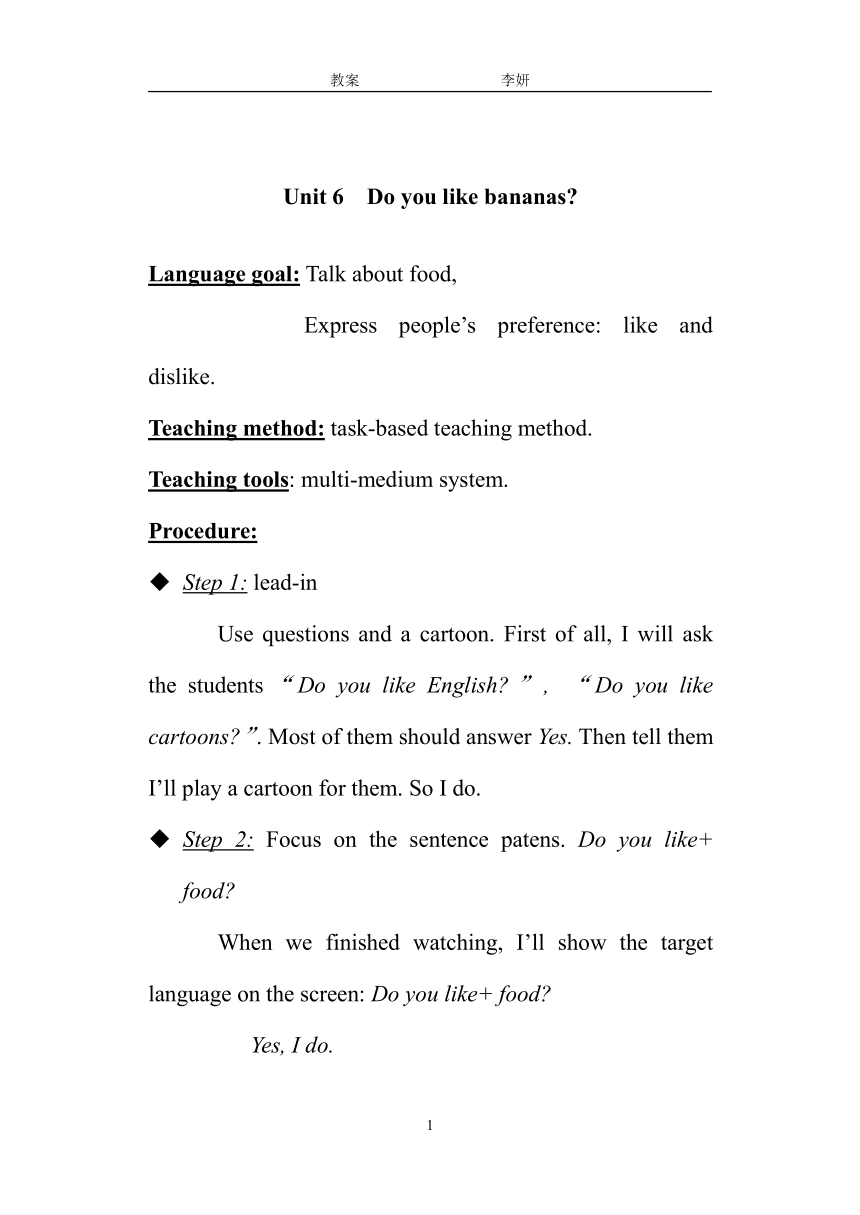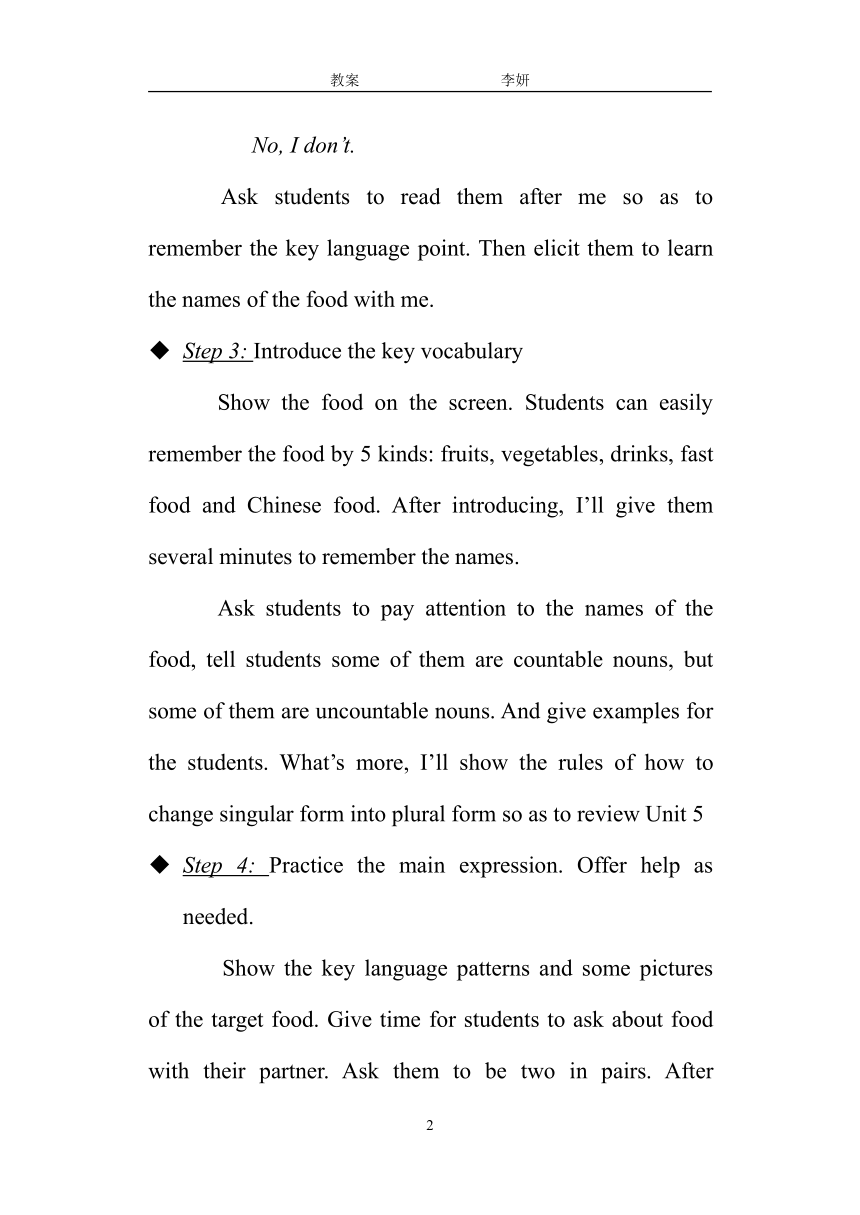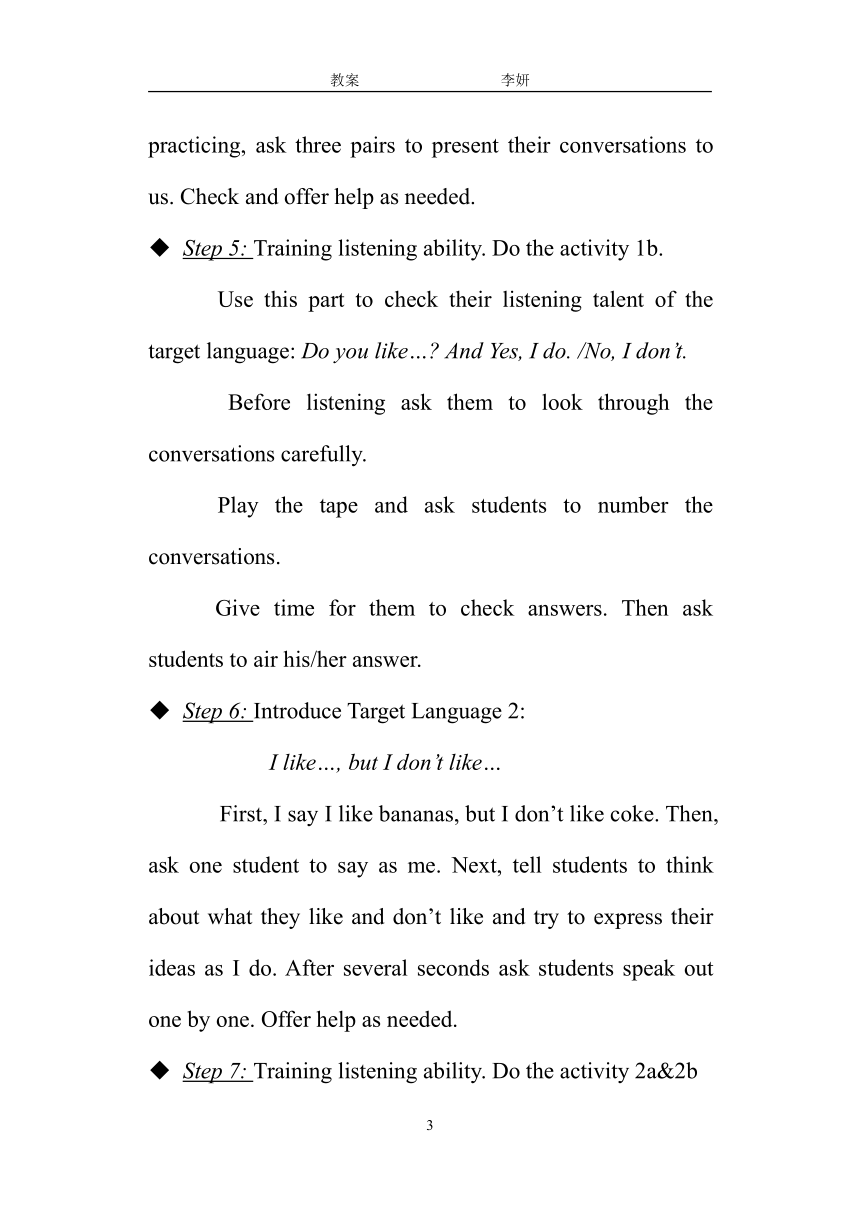unit 6 Do you like bananas.section A[?学戳]
文档属性
| 名称 | unit 6 Do you like bananas.section A[?学戳] |  | |
| 格式 | rar | ||
| 文件大小 | 6.2KB | ||
| 资源类型 | 教案 | ||
| 版本资源 | 人教新目标(Go for it)版 | ||
| 科目 | 英语 | ||
| 更新时间 | 2008-08-01 19:19:00 | ||
图片预览



文档简介
教案 李妍
Unit 6 Do you like bananas
Language goal: Talk about food,
Express people’s preference: like and dislike.
Teaching method: task-based teaching method.
Teaching tools: multi-medium system.
Procedure:
Step 1: lead-in
Use questions and a cartoon. First of all, I will ask the students“Do you like English ”, “Do you like cartoons ”. Most of them should answer Yes. Then tell them I’ll play a cartoon for them. So I do.
Step 2: Focus on the sentence patens. Do you like+ food
When we finished watching, I’ll show the target language on the screen: Do you like+ food
Yes, I do.
No, I don’t.
Ask students to read them after me so as to remember the key language point. Then elicit them to learn the names of the food with me.
Step 3: Introduce the key vocabulary
Show the food on the screen. Students can easily remember the food by 5 kinds: fruits, vegetables, drinks, fast food and Chinese food. After introducing, I’ll give them several minutes to remember the names.
Ask students to pay attention to the names of the food, tell students some of them are countable nouns, but some of them are uncountable nouns. And give examples for the students. What’s more, I’ll show the rules of how to change singular form into plural form so as to review Unit 5
Step 4: Practice the main expression. Offer help as needed.
Show the key language patterns and some pictures of the target food. Give time for students to ask about food with their partner. Ask them to be two in pairs. After practicing, ask three pairs to present their conversations to us. Check and offer help as needed.
Step 5: Training listening ability. Do the activity 1b.
Use this part to check their listening talent of the target language: Do you like… And Yes, I do. /No, I don’t.
Before listening ask them to look through the conversations carefully.
Play the tape and ask students to number the conversations.
Give time for them to check answers. Then ask students to air his/her answer.
Step 6: Introduce Target Language 2:
I like…, but I don’t like…
First, I say I like bananas, but I don’t like coke. Then, ask one student to say as me. Next, tell students to think about what they like and don’t like and try to express their ideas as I do. After several seconds ask students speak out one by one. Offer help as needed.
Step 7: Training listening ability. Do the activity 2a&2b
Before listening ask them to look through the words in the chart and the pictures carefully. Tell them to focus on the names of the food.
Play the tape and ask them to circle the food when they listen to the tape for the first time
Play the tape again and ask them to fill in the blanks when they listen to the tape for the second time.
Give time for them to check answers. Then ask two students to air his/her answer.
Step 8: Introduce Target Language 3
Tell them Let’s have a rest and see another cartoon. Then Ask them to watch carefully and answer my questions after seeing it. Play the cartoon and elicit
Does she/ he like…
Yes, she/he does. (She/He likes…)
No, she/he doesn’t.(She/He doesn’t like…)
Step 9: Pairwork, practice Target Language 3
Show a chart of Liu Xiang and Li Yu-chun’s like and dislike. Tell students to talk about their preference using Target Language 3. Give them several minutes to practice. Finally, show their conversations to us.
Step 10: Training reading ability. Do 3b
Ask students to fill in the blanks. Write about what Tom likes to eat for breakfast, lunch and dinner according to the picture. Give them several minutes to do it. Then ask them to read the article to us. Offer help as needed.
Step 11 Training writing ability. Do an exercise. Write your favorite food.
Tell students to suppose we are going on a picnic tomorrow. What kind food would they like to take for picnic Write about what they like for breakfast, lunch, and dinner. Give them the modal:
For breakfast, I like
For lunch, I …
For dinner, I …
Step 10 Homework. Use this part to review our class after school.
Tell them to ask their parents what they like to eat. Make conversation with their parents and write down their conversation
.
PAGE
6
Unit 6 Do you like bananas
Language goal: Talk about food,
Express people’s preference: like and dislike.
Teaching method: task-based teaching method.
Teaching tools: multi-medium system.
Procedure:
Step 1: lead-in
Use questions and a cartoon. First of all, I will ask the students“Do you like English ”, “Do you like cartoons ”. Most of them should answer Yes. Then tell them I’ll play a cartoon for them. So I do.
Step 2: Focus on the sentence patens. Do you like+ food
When we finished watching, I’ll show the target language on the screen: Do you like+ food
Yes, I do.
No, I don’t.
Ask students to read them after me so as to remember the key language point. Then elicit them to learn the names of the food with me.
Step 3: Introduce the key vocabulary
Show the food on the screen. Students can easily remember the food by 5 kinds: fruits, vegetables, drinks, fast food and Chinese food. After introducing, I’ll give them several minutes to remember the names.
Ask students to pay attention to the names of the food, tell students some of them are countable nouns, but some of them are uncountable nouns. And give examples for the students. What’s more, I’ll show the rules of how to change singular form into plural form so as to review Unit 5
Step 4: Practice the main expression. Offer help as needed.
Show the key language patterns and some pictures of the target food. Give time for students to ask about food with their partner. Ask them to be two in pairs. After practicing, ask three pairs to present their conversations to us. Check and offer help as needed.
Step 5: Training listening ability. Do the activity 1b.
Use this part to check their listening talent of the target language: Do you like… And Yes, I do. /No, I don’t.
Before listening ask them to look through the conversations carefully.
Play the tape and ask students to number the conversations.
Give time for them to check answers. Then ask students to air his/her answer.
Step 6: Introduce Target Language 2:
I like…, but I don’t like…
First, I say I like bananas, but I don’t like coke. Then, ask one student to say as me. Next, tell students to think about what they like and don’t like and try to express their ideas as I do. After several seconds ask students speak out one by one. Offer help as needed.
Step 7: Training listening ability. Do the activity 2a&2b
Before listening ask them to look through the words in the chart and the pictures carefully. Tell them to focus on the names of the food.
Play the tape and ask them to circle the food when they listen to the tape for the first time
Play the tape again and ask them to fill in the blanks when they listen to the tape for the second time.
Give time for them to check answers. Then ask two students to air his/her answer.
Step 8: Introduce Target Language 3
Tell them Let’s have a rest and see another cartoon. Then Ask them to watch carefully and answer my questions after seeing it. Play the cartoon and elicit
Does she/ he like…
Yes, she/he does. (She/He likes…)
No, she/he doesn’t.(She/He doesn’t like…)
Step 9: Pairwork, practice Target Language 3
Show a chart of Liu Xiang and Li Yu-chun’s like and dislike. Tell students to talk about their preference using Target Language 3. Give them several minutes to practice. Finally, show their conversations to us.
Step 10: Training reading ability. Do 3b
Ask students to fill in the blanks. Write about what Tom likes to eat for breakfast, lunch and dinner according to the picture. Give them several minutes to do it. Then ask them to read the article to us. Offer help as needed.
Step 11 Training writing ability. Do an exercise. Write your favorite food.
Tell students to suppose we are going on a picnic tomorrow. What kind food would they like to take for picnic Write about what they like for breakfast, lunch, and dinner. Give them the modal:
For breakfast, I like
For lunch, I …
For dinner, I …
Step 10 Homework. Use this part to review our class after school.
Tell them to ask their parents what they like to eat. Make conversation with their parents and write down their conversation
.
PAGE
6
同课章节目录
- starters 预备篇(2012秋审查)
- Unit 1 Good morning !
- Unit 2 What’s this in English?
- Unit 3 What color is it ?
- Unit 1 My name's Gina.
- Section A
- Section B
- Unit 2 This is my sister.
- Section A
- Section B
- Unit 3 Is this your pencil?
- Section A
- Section B
- Unit 4 Where's my schoolbag?
- Section A
- Section B
- Unit 5 Do you have a soccer ball?
- Section A
- Section B
- Unit 6 Do you like bananas?
- Section A
- Section B
- Unit 7 How much are these socks?
- Section A
- Section B
- Unit 8 When is your birthday?
- Section A
- Section B
- Unit 9 My favorite subject is science.
- Section A
- Section B
